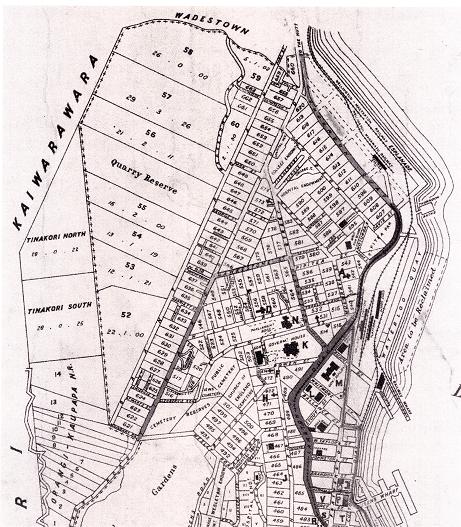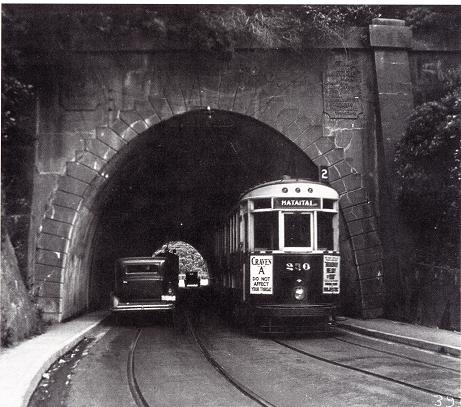TRAMWAY TO KARORI
Adrian Humphris
The development of Karori's tramway has been discussed in Henry Brittain's article in The Stockade 37, however, this article explores the events and discussions leading up to the agreement made between the Karori Borough Council and Wellington City Council to join Karori to the city's tramway system.
The opening of the Karori tramline in March 1907 was the result of over ten years' public pressure and politics.
Providing a fast, affordable means of transport to the central city became an increasingly important issue as the population of Karori grew. It was, however, not until the 1890s that the necessary technology and capital became more available for an electric tramway to become a reality.
In 1895 the Borough Council was asked to investigate construction of a tramway from Makara Hill to Wellington. A petition signed by 123 residents demanded a poll of ratepayers be taken to raise the £16,000 needed. Because there was no concrete scheme the Council did not accede to the request.[1]
The following year the Council was asked to apply for an Order-In-Council so powers could be delegated to a private company to form a tramway under the Tramways Act 1894. Again no actual scheme was proposed and they were not prepared to take any action.[2]
Also in 1896 the New Zealand Electric Light and Traction Company of London presented a £100,000 proposal to electrify Wellington's tramway, provided they were granted a 21-year concession to run the system from 1898. Their proposal included extensions to Karori Cemetery, Island Bay and Kilbirnie. Although the offer was tempting, Council was concerned about the funds involved, especially as technological improvements meant the costs of electric systems were dropping quite quickly. Instead they declined the proposal and re-opened negotiations to purchase the undertaking.[3]
In September 1897 Karori Mayor Richard Bulkley reported to the Council that "some capitalists in Wellington were interested in putting a tram to Karori and he had asked them to place a definite proposal before the Council." [4] Agreeing it was "...desirable to facilitate the endeavours to construct a tramway to Karori", a committee was established by the Council to meet with the promoters. As previously, however, little was done, and by the end of October the proposal was at a standstill.[5]
Further attempts were then delayed as the future of the city's tramway system was determined.
A private company had operated trams in Wellington since 1878. In the late 1880s the City Council investigated acquisition of it with the intention of extending the system to suburban areas around the city. No satisfactory terms could be agreed to, and it remained in private hands.
Encouraged by strong public feeling that municipalisation of the tramways would bring greater progress and benefits for both ratepayers and citizens, lengthy negotiations began and the City Council purchased the undertaking in 1900. It was claimed "That the concession of tramway rights is one of the most valuable, which can be made by a public body, goes without saying."[6]
Investigations then began on how to electrify it. "The ultimate idea", reported the Evening Post, "is to have branches running to all the suburbs..."[7] but initial plans involved a branch line finishing outside the entrance to the Botanic Gardens, at the boundary with the Karori Borough.

Part of a map compiled in 1901 by the WCC Engineer to show the existing line at the time the Council took over the Tramway system. Shaded is the proposed extension to the City Boundary at the Botanic Gardens gate. This work was completed in 1904. They could not extend further without an agreement with the Karori Borough Council. Map -- Wellington City Archives 00248:8:2 |
The line could go no further without an agreement with the Borough which by now was looking at extending it up Tinakori Road and Glenmore Street as well as negotiating with the Kelburne & Karori Tramway Company for a possible new tramway running from the Cable Car terminus in Upland Road through Karori to the foot of Makara Hill.[8] The two would link. Talks went on into 1901. At one stage ratepayers requested the Council to have a Bill put through the House to allow a loan to be raised to establish a private company to construct and run the line.[9] No terms could be agreed upon. In November 1902 a deputation of ratepayers demanded that negotiations be opened with the City Council and also with the Melrose Borough Council in the hope that joint action would improve the chances of the Kelburn tramway being constructed.[10] By May 1903 it had been agreed that the City Council's Electrical Engineer would report not only on a route via Kelburn, but also another via Tinakori Road, and a further one from Aro Street -- Polhill Gully -- up Norway Street via a tunnel to the Karori Tunnel.[11] Completed in October 1903, the report was presented to the Borough Council, and also published in The Evening Post and The New Zealand Times.[12] It had been suggested that the Tinakori Road route was the best option. The Polhill Gully route was dismissed due to the high costs involved, although it did allow a circular route across the city. The route through Kelburn required a greater level of construction, and its success in part would depend on whether the cable car remained in private hands or was taken over by the City Council. When the Karori Borough Councillors met in February 1904 to discuss the report it was unanimously agreed that a decision needed to be made before the Karori proposal was overshadowed by other suburban extensions; but two factions formed, each strongly supporting opposing routes.[13] |
Proponents of the Tinakori Road line argued this was the natural entrance to the city and it was unfair to tax Kelburn residents to construct a tramway from which they would derive no benefit. Those in support of the Kelburn route argued the much shorter route would mean cheaper fares and faster travel times. To further complicate matters several Councillors held shares in the Cable Car Company, and their credibility was questioned. Discussion was heated and the matter was deferred.
At a subsequent meeting consensus over the best route was still not achieved, and it was decided to meet with both the City Council regarding terms and fares should they construct the Tinakori Road line, and also with the Cable Car Company to further discuss the Kelburn route.[14]
By mid-1904 however, both routes seem to have hit stumbling blocks.
The City Council was beginning work on extensions to Kilbirnie, Island Bay and Brooklyn and advised the Borough Council in June that although the branch line to the Karori boundary was completed, they had no immediate plans to extend the tramway to the cemetery.
There were more negotiations with the Cable Car Company but still no agreement could be reached on any aspects of the proposal.
The Borough Council continued to investigate options and gather additional information on which to base a decision on the best means and route for a tramline. An offer to provide a report on a suitable system by visiting Electrical Engineer, Edmund Allo, was accepted in July, although whether the report was ever completed or used by the Borough Council has not been ascertained.
Allo was later contracted to carry out surveys for the road widening required. The Council also investigated the "Lombard-Gerin" system of trams, which had been adopted by the Dunedin City Council.
Persistent ratepayer demands for action were finally rewarded in February 1905 when the Borough Council distributed a report on a proposed tramway to ratepayers, and in March they exhibited a kinematographic film showing how the Lombard-Gerin system worked.

A Hataitai bound tram exits the tunnel on the city side in 1935. The last tram ran to Karori on Friday October 1, 1954 and the trolley bus service began operating on Monday 4 October. WCC Archives -- ref no. 00146:1:232 |
Although by this stage the Tinakori Route appears to have been the preferred, the Council had still not completely discounted the Kelburn route, meeting with the Cable Car Company in April to discuss possible fare options should the Karori line connect with the cable car. By June 1905 however, the Borough Council had formally decided that the Tinakori Road route should be adopted, and requested the City Council report on whether they would be prepared to run a service if the Borough constructed the line and overhead equipment. The City Council by this stage seemed amenable to such a proposal, and, by November after discussion of terms and conditions, it was officially adopted. Under the agreed terms the Borough would construct lines within their own boundaries and pay the City Council for their maintenance. The City Council would provide trams, power, motormen and conductors, at a charge of one shilling per car mile run. The level of service suggested, could be altered if requested by the Borough. With an agreement in place the Borough Council could then make progress, and a poll of ratepayers held on 31 January 1906 voted unanimously to raise the loan required to construct the line. After a decade of discussion, Karori's trams were just months away. |
Notes
[1] 00112/1 ppl07,108. Meeting of Karori Borough Council, 16/4/1895
[2] 00112/1 pl39, 17/3/1896
[3] 00166/10: pp31-32, Wellington City Council meeting, 27 August 1896
[4] 00112/1 pp200-201, 21/9/1897
[5] 00112/1 p203, 19/10/1897
[6] 00166/14: p207, from Newspaper article (unknown). Council meeting dates 13 August 1900
[7] WCC Tramways Department, Newspaper Clipping Book 1
[8] 00112/2 pl4, 18/9/1900
[9] 00112/2 pp75, 76
[10] 00112/2 pl56
[11] New Zealand Times, 8/5/1903, 23/2/1903
[12] Evening Post, 28 October 1903, New Zealand Times, 29 October 1903
[13] New Zealand Times, 16 February 1904, Evening Post, 16 February 1904
[14] Evening Post, 23 February 1904
Bibliography
Minutes of the Karori Borough Council
00112:0:1 Minutes of Karori Borough Council, 1891-1900
00112:0:2 Minutes of Karori Borough Council, 1900-1905
00112:0:3 Minutes of Karori Borough Council, 1905-1909
Minutes of the Wellington City Council
00166:0:10 Minutes of Wellington City Council, 1896-1898
00166:0:14 Minutes of Wellington City Council, 1902-1903
WCC Tramways Department, Newspaper Clipping Book 1
00318:1:1 Newspaper extracts, 1908-1911
00233:117:1905/1094 Proposed tramway to Karori -- Town Clerk, Karori; Electrical Tramway Engineer, Wellington; Upland Estate Co; Karori Borough Council, 1905-1907
Evening Post, 28 October 1903
Evening Post, 16 February 1904
Evening Post, 23 February 1904
New Zealand Times, 23 February 1903
New Zealand Times, 8 May 1903
New Zealand Times, 29 October 1903
New Zealand Times, 16 February 1904
Evans, L (1972). The Commuter, The Car and Metropolitan Wellington: The Rise and Decline of Public Transport. Victoria University of Wellington, Wellington
From The Stockade 39, 2007